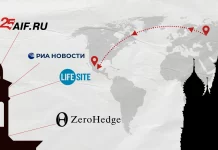By EUvsDisinfo
The Kremlin downplays Ukraine’s devastating attack on Russian military airfields, looking for distractions and feebly recycling old lies about terrorism and Anglo-Saxons instead.
This has certainly been a challenging week for the Kremlin’s information manipulators, as a carefully woven Ukrainian spider web covered several strategic military airfields in Russia and clogged up the gears of the Kremlin’s disinformation machinery in the process.
The railway bridge collapse in the Bryansk region and a surprise underwater attack on the Kerch bridge only compounded the Kremlin’s conundrum – how to spin the tale that Ukraine is all but done and dusted while the Russian hinterland is on (recently literal) fire? The answer comes straight from the Kremlin’s playbook – downplay anything that might reveal Russia’s weakness and look for distractions elsewhere.
All quiet at the top
On 1 June, Ukraine tipped its hand, revealing the aces tucked in its sleeve until the moment was right. It launched Operation Spiderweb – carefully planned and daring covert drone strikes against five Russian military air bases from Siberia to Murmansk. Judging by the initial estimation of the damage inflicted, the Russian military was caught entirely off guard. And so was the pro-Kremlin information manipulation apparatus all the way to the top of the Kremlin. While the Russian military did reluctantly admit that ‘several pieces of military equipment had caught fire’, Putin himself has kept quiet for days after the attacks.
Even Vladimir Solovyov, one of the most vociferous and bellicose pro-Kremlin propagandists, was uncharacteristically tame in his pontifications, referring to the unprecedentedly successful Ukrainian operation as ‘unpleasant incidents’. A weird show of self-restraint from a man who frequently threatens Western capitals with nuclear annihilation. Or far more likely, the marching orders from the top of the Kremlin, sometimes referred to as a temnik, simply had not arrived yet.
Play it safe and recycle old lies
In the absence of top-level guidance on how and what to spin, the pro-Kremlin disinformation ecosystem quickly fell back on recycling old lies it perceives to be a fail-safe option for any occasion. First step – downplay the impact. Second step – vilify Ukraine and play the victim. Third step – peddle unfounded conspiracy theories to muddle the waters. Forth step – maintain the myth of Russia’s invincibility and add a bit of nuclear sabre-rattling for safe measure.
One of the go-to pro-Kremlin tactics to vilify Ukraine is to blame it for terrorism against Russia. Hence, the pro-Kremlin infosphere was quickly filled with stories accusing Ukraine of terrorism and calling the hitting of military airfields in Russia a Ukrainian terrorist attack. Initially, this was almost a universal depiction of the Ukrainian operation against legitimate military targets in Russia.
This goes hand in glove with wishful claims that Ukraine has already lost the war and is attacking Russia to derail peace negotiations. If anything, the Ukrainian strikes against Russian airfields are a testament to Kyiv’s commitment to peace because it knows all too well that the path to peace with Russia lies in depriving Russia of the military means to wage war. And this is exactly what Operation Spiderweb sought to accomplish.
Diminish Ukraine and blame the West
Another fail-safe option – sow doubts and dismiss the very idea that Ukraine would be capable of inflicting real pain on mighty Russia. Pro-Kremlin mouthpieces then use this doubt to peddle various baseless conspiracy theories, such as claiming that British strategists might be behind the attacks or accusing London of using Ukraine to undermine Russia’s nuclear triad.
Finally, like always when faced with defeat and embarrassment, pro-Kremlin pundits like to remind the world of Russia’s nuclear arsenal. This seemingly academic pondering about the implications of Russia’s nuclear doctrine is in fact a calibrated tactic of nuclear sabre-rattling to reinforce the Kremlin’s faux red lines.
The shortcomings of total information control on full display
Moscow’s semi-paralysed, haphazard response to Operation Spiderweb is not the first time the Kremlin’s total information control has exposed a fundamental weakness inherent in its authoritarian system. When confronted with the unexpected or the unimaginable, all eyes turn to the very top of the Kremlin, and if the tsar keeps mum, the underlings are left sans ideological footing for their propaganda.
When Putin was conspicuously absent from the public eye for 19 hours following the Crocus City Hall attack in 2024, the pro-Kremlin disinformation ecosystem experienced a similar moment of initial paralysis. Eventually, it followed up with the same approach to distract from the hinterland on fire as is currently deployed to spin and downplay the impact of Operation Spiderweb.
The same cracks and inherent weakness were also on full display during the ill-fated Wagner mutiny led by Yevgeny Prigozhin in 2023, when Putin took almost two days to release his televised address laying down the narrative to be followed by any and all purveyors of pro-Kremlin disinformation. But during those two initial days, the tightly controlled information manipulation apparatus was in a veritable state of panic. It recovered then, as it will surely recover now, but the cracks have been exposed and will remain for all to see, as Ukraine continues to chip away at the myth of Russia’s invincibly. Don’t be deceived.

Also on our EUvsDisinfo radar this week:
- The Kremlin often tries to project Russia’s own wrongdoings onto others. Hence the false claim that Ukraine systematically tortures Russian prisoners is not altogether surprising, especially since this claim is spread by such a well-known pro-Kremlin disinformation outlet as RT. In fact, the UN Office of High Commissioner for Human Rights only applied the term ‘systematic’ for the mistreatment, torture, and abuse of Ukrainian prisoners at the hands of Russian authorities, not the other way around. By spreading such manipulative claims, Moscow sought to distract from a ground-breaking investigation by the Associated Press revealing the widespread Russian mistreatment of Ukrainian prisoner of war, as well as revelations about the notorious Taganrog prison and other detention facilities.
- Following a similarly absurd upside-down logic, the Kremlin’s disinformation propagators also falsely claimed that Russia protects children in Ukraine. This bizarre claim seeks to divert attention from Russia’s well-documented involvement in abducting Ukrainian children. Due to Russia’s war against Ukraine, hundreds of Ukrainian children have been injured or killed, as verified by the UN Human Rights Office. Because of Russia’s aggression, another 1.7 million children have become refugees. Russian crimes against children, including abductions and illegal deportations, have been recognised by the International Criminal Court, that issued arrest warrants for Vladimir Putin and Russia’s children’s ombudsman Lvova-Belova, based on compelling evidence. These abductions have been documented also by the United Nations, OSCE, Human Rights Watch, Amnesty International, and many other reputable sources.
- Finally, a telling example of the Kremlin’s penchant for freebasing copium – claiming that sanctions have turned Russia into an economic superpower. This disinformation story is part of what some experts have labelled Russia’s economic war propaganda, aimed at convincing the world of the futility of the sanctions imposed on Russia for its aggression against Ukraine. Actual data shows a very different picture (see here and here for two well-researched summaries of the economic situation of Russia at the end of 2024). For example, the Russian ruble has been following a downward trend for over a decade and plummeted in the last quarter of 2024, reaching a record low. The liquidity of Russia’s National Wealth Fund (NWF) more than halved between 2022 and 2024, with no improvement in sight for 2025.
By EUvsDisinfo





